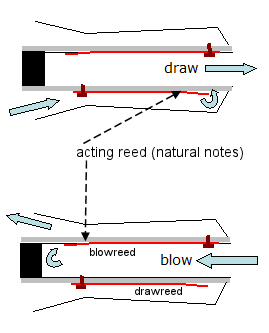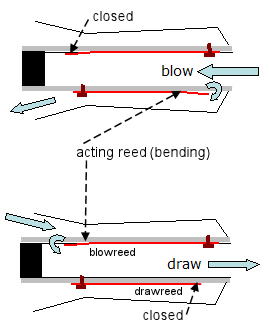Physics of Bending
Double Reed Bending
If you bend a note on a Blues-Harmonica there are always two reeds involved in producing the sound (the principle of the "closing" and "opening" reed). If you play a regular or natural note only one reed is acting:

Reed action while playing a natural note (blow below, draw above)
| missing notes blow | Eb1 | Eb2 | f#2 | Bb2 | ||||||
|
|
|
|
|
|
|
|
|
|
Bb3 | |
| Eb3 | f#3 | B3 | ||||||||
| Blow | c1 | e1 | g1 | c2 | e2 | g2 | c3 | e3 | g3 | c4 |
| Hole# | 1 | 2 | 3 | 4 | 5 | 6 | 7 | 8 | 9 | 10 |
| Draw | d1 | g1 | b1 | d2 | f2 | a2 | b2 | d3 | f3 | a3 |
| missing notes draw | Db1 | f#1 | Bb1 | Db2 | Ab2 | |||||
| f1 | a1 | |||||||||
| Ab1 | ||||||||||
| Db3 | Ab3 | Db4 |
All possible notes on a Blues Harmonica - Bending notes are indicated in dark grey (overbends are orange - these are not matter of this article) - natural notes in light green.
Draw Bendings
For example: on a C-harmonica you will find a D in hole 1 draw and a two semitones lower C in blow 1.
While the player is bending down a note he has to adjust his mouth cavity and tongue in a way that the draw reed producing D is stopped (= closing reed).
If the mouth cavity (embouchure) is altered as if you would vocalize the syllable "eeouhh" the D-reed stops its action. You are still drawing air out of this hole and there is the C-blow reed that starts vibrating now (by overtaking the "energy" from the D reed in the same hole = opening reed).

Reed action while playing a bending note (blow above, draw below)
If drawn, the C reed produces a pitch that is more or less exactly in between the D and the C - namely you will hear a Db/ or C# (which is the same note) - please be aware of the fact that a blow reed is acting while the player draws the note!
All draw notes in hole 1-6 on a Blues harmonica work together like this if you bend them down. The draw not in each hole is tuned to a higher note than the blow reed. The possible bending notes fill "the space in between" those two natural notes in one hole, for example:
In hole 5 the draw note is an F and the blow note is an E - there is no semi-note in between these two and that's why the 5 draw note cannot be bent down only for much less than a semi-note. This fact has NOTHING to do with stiffness or thickness of the reeds in this hole.
Blow-Bendings
Because of the nature of the Richter tuning all notes from hole 7 upwards work exactly vice versa: changing the embouchure to produce a smaller mouth cavity (like vocalizing a "aeeee") makes the blow reed stop its action (=closing reed) and the former draw reed starts producing the bent note (=opening reed).
Here the blownote has a higher pitch than than the drawnote in the same hole - while bending the blow reed that acts as the closing reed the the draw reed becomes the opening reed. That is why notes in holes 7 to 10 can be bent down by blowing (= blow bendings).
To which extend the pitch of a note can be bent down?
The depth of the bent pitch is the result of the interval of the two notes in a certain hole, for example:
While bending the higher pitched E and the D in hole 8 can produce a D#/Eb. In hole 8 you will find a C and and a B (=German H). In between these two there is no semi-tone available and blow bending is nearly impossible here. According to the intervals of the notes present in the holes of a Richter harmonica the blow note in hole 10 and the draw note in hole 3 can be bent to the maximum extend of 3 semi notes - intonating the three semitones is not an easy job and requires a good ear and some practice.
Single Reed Bending
Another kind of bending can be achieved with only one reed involved. This type of bending is found on valved instruments or harmonicas that have an individual hole for each reed. This means that the blow and the draw reed are physically separated from each other. The pitch of the so called single-reed bendings is one semi note maximum.
The necessary embouchure is just like the one for double reed bendings, but the bent note it is hard to be sustained - the playing pressure has to be adjusted very carefully - if too high the sound is stopped. However these bendings are used more for decoration of a note and for sure they can add color and feeling to a chromatic harmonica solo!







